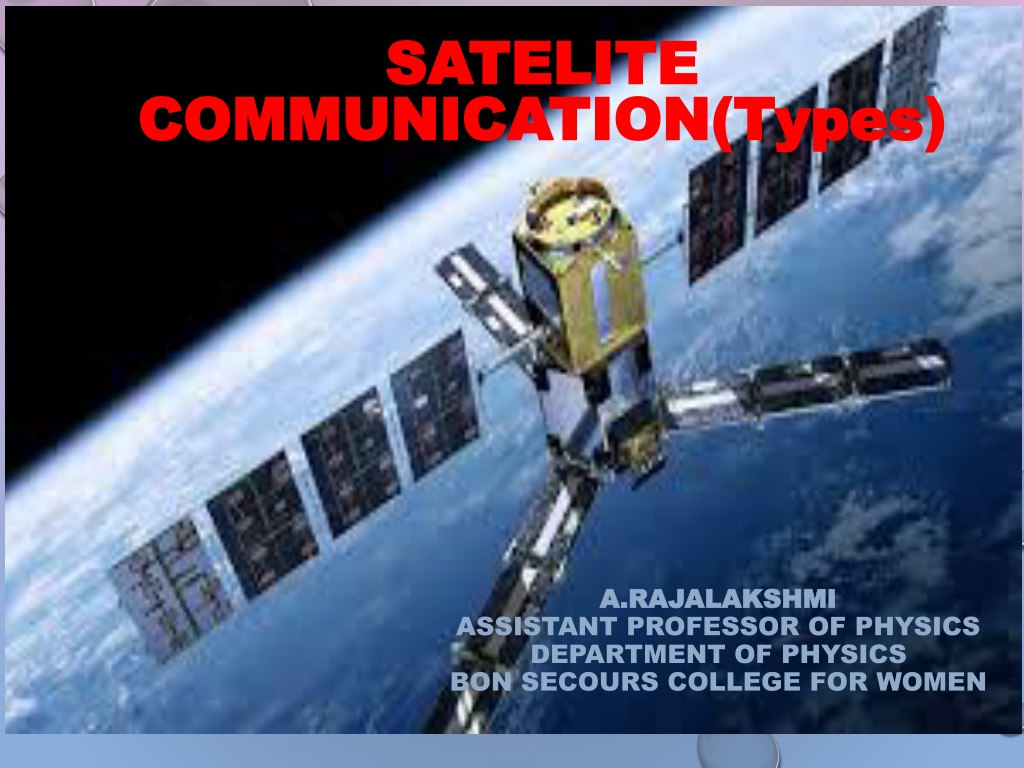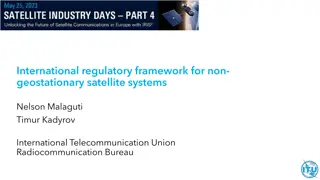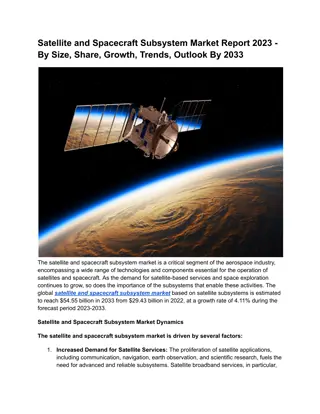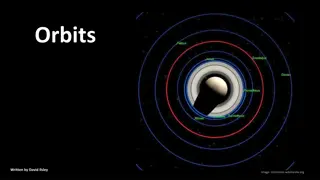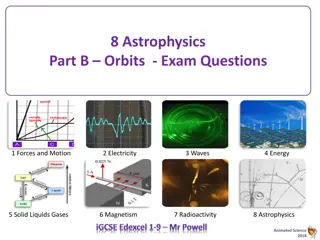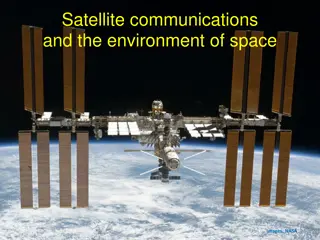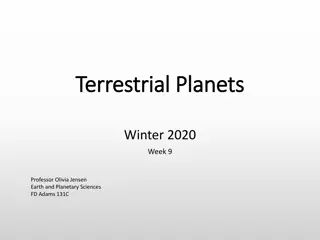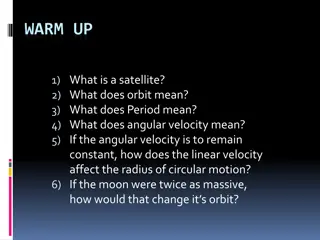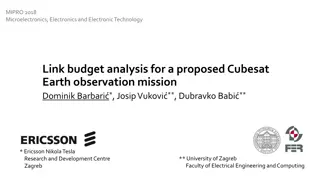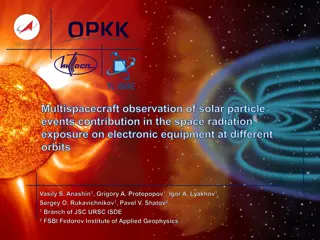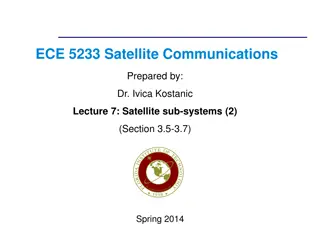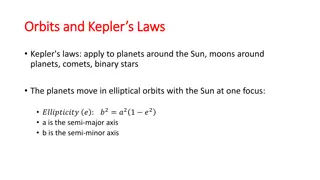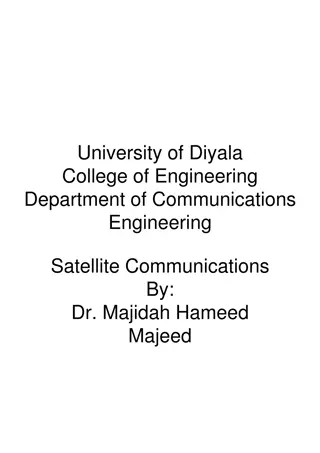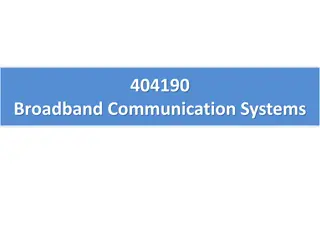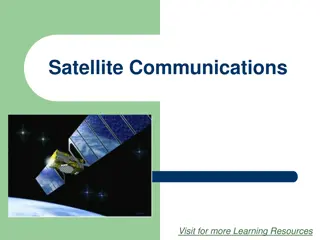Understanding Different Types of Satellite Communication Orbits
Explore the various types of satellite communication orbits, including Geostationary Earth Orbit (GEO), Low Earth Orbit (LEO), Medium Earth Orbit (MEO), and Highly Earth Orbit (HEO). Learn about the advantages and disadvantages of each orbit in relation to satellite communication technologies.
Download Presentation

Please find below an Image/Link to download the presentation.
The content on the website is provided AS IS for your information and personal use only. It may not be sold, licensed, or shared on other websites without obtaining consent from the author. Download presentation by click this link. If you encounter any issues during the download, it is possible that the publisher has removed the file from their server.
E N D
Presentation Transcript
SATELITE SATELITE COMMUNICATION(Types) COMMUNICATION(Types) A.RAJALAKSHMI A.RAJALAKSHMI ASSISTANT PROFESSOR OF PHYSICS DEPARTMENT OF PHYSICS BON SECOURS COLLEGE FOR WOMEN
TYPES OF SATELLITE TYPES OF SATELLITE COMMUNICATION COMMUNICATION GEO- GEOSTATIONARY EARTH ORBIT LEO- LOW EARTH ORBIT MEO- MEDIUM EARTH ORBIT HEO- HIGHLY EARTH ORBIT
GEOSTATIONARY EARTH ORBIT A circular orbit positioned approximately 35,900 km (22,258 mi) above earth's equator and having a period of the same duration and direction as the rotation of the earth. An object in this orbit will appear stationary relative to the rotating earth. Advantages of GEO satellite Receivers and senders can use fixed antenna positions, no adjusting is needed. GEOs are ideal for TV and radio broadcasting. Geostationary satellites have a 24 hour view of a particular Disadvantages of GEO satellite area. GEOs typically do not need handover due to the large These satellites can't be used for small footprints. mobile phones. GEOs don't exhibit any Doppler shift because the relative movement is zero. Transferring a GEO into orbit is very expensive.
LOW EARTH ORBIT Leo (low earth orbit) at about 500-1500km above the earth s. Additionally, LEO systems try to ensure a high elevation for every spot on earth to provide a high quality communication link. Each LEO satellite will only be visible from the earth for about ten minutes Advantages of LEO satellite A LEO satellite smaller area of coverage is less of a waste of bandwidth. Disadvantages of GEO satellite Smaller footprints of LEOs allow for better frequency. The problem is the need for many GEOs don't exhibit any Doppler shift because the relative satellites if global coverage is to be reached. movement is zero. High complexity.
MEDIUM EARTH ORBIT A MEO satellite situates in orbit somewhere between 6,000 km to 40,000 km above the earth's surface. Using orbits around 10,000km, the system only requires a dozen satellites which is more than a GEO system, but much less than a LEO system Disadvantages of GEO satellite Advantages of MEO satellite Larger distance to the earth, delay increases to MEO satellites have a larger coverage area than LEO. about 70-80 ms. Visible for much longer periods GEOs between 2 to 8 hours. The satellites need higher transmit power and special antennas for smaller footprints
HIGH EARTH ORBIT HEO is one of the non-circular orbit of the four types. It operates in an eppiptical move which is similar to GEO with maximum altitude and LEO with minimum altitude Advantages of HEO satellite Disadvantages of GEO satellite The coverage can be done of high latitude locations Longer signal delays Fewwer satelites can be required
REFERENCES GOOGLE SITES https://www.Google.Com/search?Q=types+of+satelite+orbits&oq=types+of+ &aqs=chrome.0.69i59j69i57j35i39l2j0l3j69i61.4334j1j7&sourceid=chrome&ie =utf-8
THANK YOU THANK YOU
